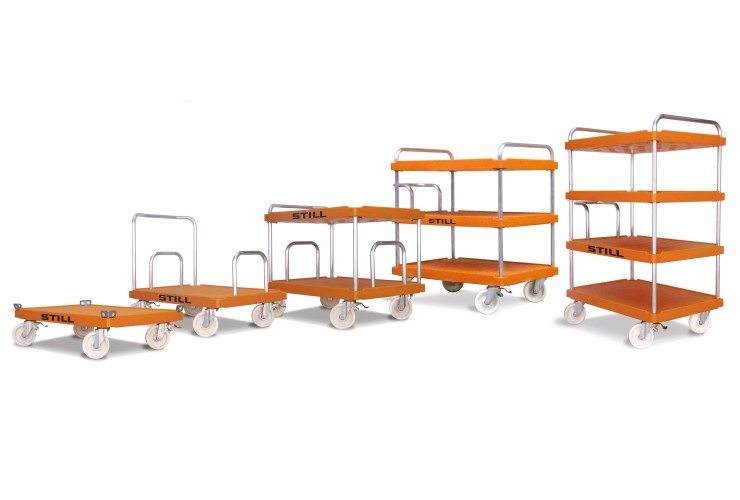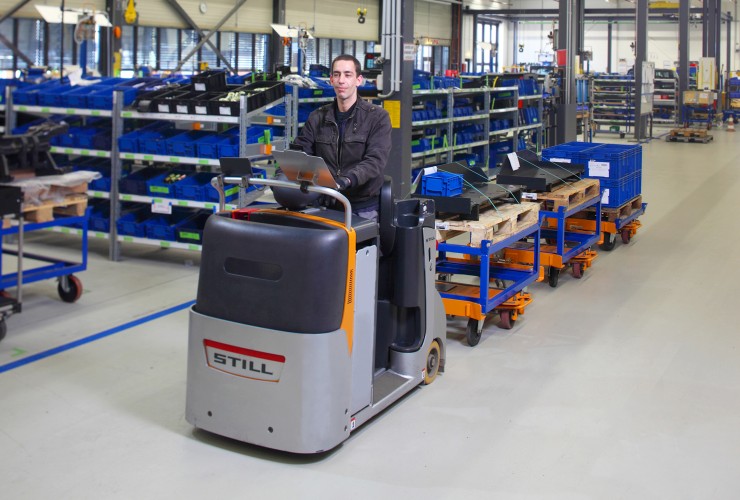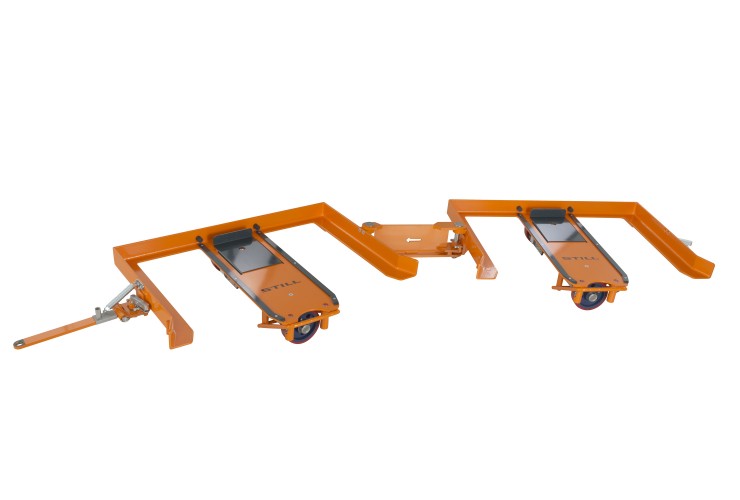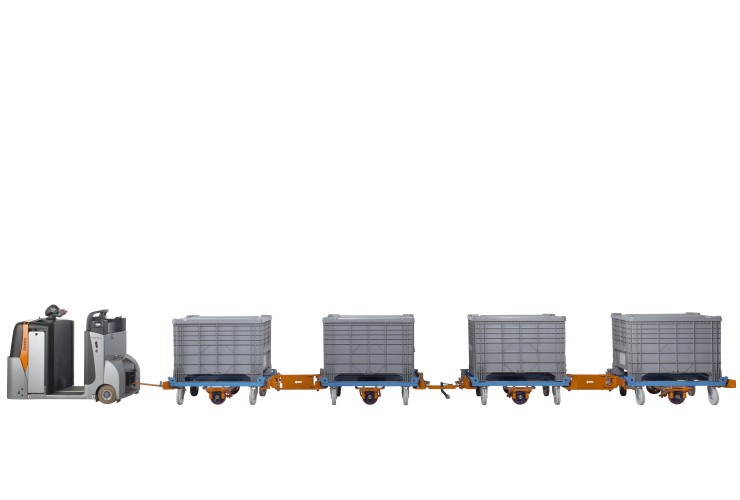IFOY Schirmherrschaft
IFOY Träger
IFOY Partner
Das STILL-Routenzugkonzept
Still GmbH
IFOY-Kategorie
Warehouse Trucks
Kurzcharakteristik
„Autarke Routenzuganhänger für leichtes Pallettenhandling“
Im Zuge neuartiger Produktions- und Logistikkonzepte (lean production) geht die Entwicklung in die Richtung, neben Effizienzsteigerung und Kostensenkung (Betriebs- und Personalkosten) auch jeglicher Art von Verschwendung vorzubeugen. Wartezeiten, unnötige Transporte, Materialbewegungen und Nacharbeiten sollen auf ein Minimum beschränkt werden. So ist die Idee der Zukunft, eine staplerarme Fabrik zu gestalten, in der nahezu alle Transporte und Bestandsbewegungen von Routenzügen durchgeführt werden.
Für diesen Trend hat STILL eine neue Variante des Routenzuges entwickelt, welche nicht nur die Effizienz steigert, sondern auch in den Bereichen Sicherheit und Umweltfreundlichkeit punktet. Mit dem neuen Routenzug wird die Handhabung für den Nutzer noch angenehmer, die Umschlagsleistung noch höher und die Anwendungsmöglichkeiten noch vielfältiger.
IFOY Test
| Truck Name | Still CX Routenzug |
| Truck Type | Towing Truck |
| Date of Test | 14.03.2013 |
Testbericht
Im Zuge neuartiger Produktions- und Logistikkonzepte (lean production) geht die Entwicklung in die Richtung, neben Effizienzsteigerung und Kostensenkung (Betriebs- und Personalkosten), auch jegliche Art von Verschwendung zu vermeiden. Wartezeiten, Nacharbeit, unnötige Transporte und Materialbewegungen sollen auf ein Minimum beschränkt werden. So hat Still die Idee einer staplerarmen Fabrik umgesetzt, in der nahezu alle Transporte und Bestandsbewegungen von Routenzügen durchgeführt werden. Für diesen Trend haben die Entwickler eine neue Variante des Routenzuges entworfen und gebaut, die nach Herstellerangaben nicht nur effizienter ist als vergleichbare Routenzugkonzepte am Markt, sondern die auch in den Bereichen Sicherheit und Umweltfreundlichkeit punktet. Mit dem neuen Still-Routenzug wird die Handhabung für den Nutzer noch angenehmer, die Umschlagsleistung noch höher und die Anwendungsmöglichkeiten noch vielfältiger.
Das Routenzugkonzept, das seit seiner Einführung im Jahr 2011, ständig weiterentwickelt und perfektioniert worden ist, ermöglicht in der Praxis einen flexiblen und einfachen Transport. Für den IFOY Test wird von Still ein CX-T als Zugfahrzeug für den Routenzug zur Verfügung gestellt. Der Schlepper verfügt über eine maximale Anhängelast von 4 Tonnen. Für schwerere Transporte ist ein Still R 06 Schlepper (bis 6 Tonnen) und seit Kurzem ein Still R 07 (mit einer maximalen Zugkapazität von 25 Tonnen) mit gleichem Konzept lieferbar. Aber selbst wenn das Zugfahrzeug von einem anderen Hersteller oder in einer gemischten Flotte eingesetzt wird, hast es zahlreiche Vorteile.
Der CX-T ist lieferbar mit einer eingebauten hydraulischen Pumpe und Kupplung. Diese ist auch als pneumatische Version erhältlich, zum Beispiel für die Verwendung in der Lebensmittelindustrie. Da die Ladungsträger auf den Anhängern während der Fahrt angehoben werden und somit keinen Bodenkontakt haben, verschleißen die Räder deutlich weniger und der Transport ist angenehm leise.
Die Anhänger werden mit C- und E-Profilen geliefert. Der E-Rahmen (beim IFOY Test in Verwendung) ist mit nur einer Achse ausgerüstet. Damit ist der Zug im Test sehr wendig. Die Gummiräder der Anhänger sind hierbei extrem leise. Die E-Profil Anhänger verfügen über ein eigenes Hydrauliksystem an Bord. Während des Transports wird durch die Bewegung Druck aufgebaut und gespeichert. Anschließend wird dieser, beim Be- oder Entladen der Trolleys auf den Anhängern, wieder zum Senken und nach dem Handling zum Heben genutzt. Das Heben der Anhänger geschieht automatisch sobald der Trolley bis an den Anschlag gefahren wird. Dank dem integrierten Hydrauliksystem ist eine zusätzliche Verbindung zwischen den Anhängern überflüssig und somit das Risiko von Leckagen ausgeschlossen. Falls gewünscht, kann der Benutzer bei der Verwendung des Routenzugs lediglich den entsprechenden Anhänger senken oder heben. So wird weniger Energie verbraucht, obwohl die Einsparung nur marginal sein wird.
Mit dem Routenzugkonzept bietet STILL eine Plug & Play-Lösung, die schnell und ohne Werkzeug auf die spezifische Situation des Kunden angepasst werden kann. Die Anhänger sind wendig und leicht zu manövrieren. Darüber hinaus benötigt der Benutzer wenig Kraft, um die Trolleys ein- oder aus zu fahren und die Lasten werden automatisch gesichert, so dass ein sicherer Betrieb immer gewährleistet ist.
Fazit
Während der Fahrt mit dem Routenzug folgen die Anhänger perfekt der gewählten Route. Dies macht den Einsatz präzise und sicher. Der Schlepper basiert auf dem CX-Kommissionierer, der bereits seit mehreren Jahren auf dem Markt verwendet wird. Das Fahrzeug ist einfach bedienbar, bequem für den Fahrer und bietet eine sehr niedrige Einstiegshöhe.
Hard Facts
| Test Truck IFOY Test | Average other trucks | Value 1 to 10 | |
| Productivity Max mode (tows) | no measurements | 7 | |
| Productivity Eco mode (tows) | no measurements | 7 | |
| Energy level Max mode (kWh towing) | no measurements | 7 | |
| Energy level Eco mode (kWh towing) | no measurements | 7 | |
| Driving speed with load (km/h) | 10,78 | ||
| Acceleration speed (time for 27,2 meters) | 10,4 |
Averages soft facts
| First impression | 8,00 |
| Load Safety | 7,00 |
| Entry to truck | 8,57 |
| Seat & Sit position | 9,00 |
| Legg Space | 8,50 |
| Activate truck | 8,00 |
| Steering | 7,43 |
| Sight | 9,00 |
| Driving acceleration | 8,60 |
| Driving braking | 8,00 |
| Driving & Turning | 7,33 |
| Parking truck | 8,17 |
| Safety elements | 7,60 |
| General after test | 7,38 |
| Sustainability | 8,00 |
| Total average soft facts | 8,04 |
| Total productivity | 7,00 |
| Total Energy consumption | 7,00 |
| Total result all facts | 7,52 |
Bewerbungsdaten
Datenblatt
| Download Link | Datenblatt |
Gerätetyp
| Routenzuganhänger/ Trolleys |
Technische Daten (alle Geräte)
| Antrieb | Elektro |
| Tragfähigkeit | 1000 kg |
| Eigengewicht | 170 kg |
| Bedienung | Stand |
| Fahrgeschwindigkeit mit Last | 15 km/h |
| Fahrgeschwindigkeit ohne Last | 15 km/h |
| Hubgeschwindigkeit mit Last | m/s |
| Hubgeschwindigkeit ohne Last | m/s |
| Senkgeschwindigkeit mit Last | m/s |
| Senkgeschwindigkeit ohne Last | m/s |
| Max.Hubhöhe | mm |
| Energieverbrauch nach VDI-Arbeitsspiel | |
| Elektro-Trucks | |
| Batteriespannung | 24 V |
| Batteriekapazität | 450 Ah |
| Batterieanschluss | |
| Batteriegewicht | 410 kg |
| Leistung Fahrmotor | 3 kW |
| Leistung Hubmotor | kW |
| Schlepper | |
| Nennzugkraft | 1600 N |
| Kommissionierer/Kombigeräte | |
| Max. Greifhöhe | mm |
Sonstiges
| Es handelt sich um ein(e) |
Weiterentwicklung mit signifikanten technischen Verbesserungen eines oder mehrerer bestehender Modelle: E-Rahmen, Metall-Trolleys |
| Datum der Markteinführung | 01.07.2011 |
| Datum des Produktionsstarts | 03.10.2011 |
Innovationen
Bisher bestand der STILL Routenzug aus einem Zugfahrzeug mit pneumatisch oder hydraulisch angetriebenem C-Rahmen oder E-Rahmen. Bei dem neu entwickelten, autarken E-Rahmen ist die Druckerzeugung für den Hubvorgang bereits im E-Rahmen integriert. Damit entfallen hydraulische oder pneumatische Verbindungen zwischen den einzelnen Anhängern/ Ladungsträgern mit dazugehörigen Trolleys. Dies spart nicht nur Zeit, sondern auch elektrische Energie. Der Druck muss nicht mehr für das Anheben aller Anhänger, sondern nur für den gerade entladenen erzeugt werden. Wenn der Austausch-Trolley bis zum Anschlag eingeschoben wird, hebt sich der E-Rahmen automatisch hydraulisch an. Die autarken Anhänger ermöglichen eine noch flexiblere Zusammenstellung der Routenzüge, z.B. bei Wechselbetrieb eines Schleppers mit mehreren Zügen.
Die Mitarbeiter in der Produktionsversorgung müssen oftmals schwere Trolleys ziehen und schieben. Um das Handling zu erleichtern, ist es deshalb wichtig das Eigengewicht der Trolleys zu minimieren. Die innovative Produktreihe der robusten Kunststoff-Trolleys ist hierfür ideal geeignet. Sie ist als modulares Baukastensystem für Lasten bis zu 1000 kg konzipiert und erleichtert das Lasthandling in Produktion, Lagerhaltung und Werkstatt.
Hauptziele der Entwicklung
Bei der Entwicklung des autarken Rahmens und der dazugehörigen Trolleys hat STILL es sich zum Ziel gesetzt, nicht nur das Handling deutlich zu erleichtern, sondern auch die Effizienz zu optimieren und die Betriebssicherheit bei Ausfall eines Schleppers zu erhöhen.
Bei der Entwicklung galt es, den pneumatisch oder hydraulisch bedienbaren C-Rahmen und E-Rahmen des herkömmlichen Routenzuges zu verbessern. Vor allem die Zeitintervalle, die benötigt werden, um den Austausch von Schleppern oder bestimmten Rahmenkomponenten zu vollziehen, sollten verringert werden. Bei Ausfall oder akutem Defekt eines Schleppers ist oft kein passendes Gerät als Ersatz vorhanden. Im Normalfall wird der Schlepper nur notdürftig, also ohne pneumatische/hydraulische Verbindung, an den Schlepper angebaut. Die Betriebssicherheit ist dadurch nicht mehr gegeben. Hier galt es eine Lösung zu finden, die zum einen kostengünstig und zum anderem universell und funktionell ist. Die Optimierung der Handhabung des Routenzuges war ein weiteres Ziel der Entwicklung. Diese galt es für den Arbeiter zu erleichtern, und den Routenzug noch flexibler zu gestalten durch beidseitige Beladung, schlankerer Aufbau, einfaches Entnehmen und Einschieben der Trolleys.
Kundennutzen
Durch das Entfallen von pneumatischen bzw. hydraulischen Verbindungen zwischen den einzelnen Anhängern werden Arbeitszeit und elektrische Energie gespart. Jeder Ladungsträger kann gezielt angehoben oder gesenkt werden, so dass Energie nur für den jeweils benötigten Ladungsträger genutzt werden muss. Je mehr Ladungsträger im Routenzug genutzt werden, umso mehr Energie wird eingespart. Während der Fahrt lädt eine mitlaufende Pumpe den unter dem Anhänger-Chassis verbauten Druckspeicher auf. Die autarken Anhänger ermöglichen eine noch flexiblere Zusammenstellung der Routenzüge und die Zeitintervalle beim Umbau der Züge werden reduziert. Durch die autarke Druckerzeugung im Rahmen wird nicht nur Platz gespart und das Ölverlustrisiko minimiert, sondern auch die Sicherheit wird erhöht. Die Anhänger können eigenständig ohne Abhängigkeit zum Schleppgerät agieren.
Die innovative Produktreihe der robusten Kunststoff-Trolleys ist ideal geeignet für den Einsatz im STILL Routenzug. Sie ist als modulares Baukastensystem für Lasten bis zu 1000 kg konzipiert und erleichtert das Lasthandling in Produktion, Lagerhaltung und Werkstatt. Das geringe Gewicht der Kunststofftrolleys trägt zu einer deutlichen Reduzierung der Transportlast bei und vermindert dadurch Energieverbrauch, Bodenbelastung und Kraftaufwand der Mitarbeiter. In einer achtstündigen Schicht mit einer Taktung von zehn Minuten und vier E-Rahmen kann so beispielsweise das zu transportierende Gewicht um 1152 kg reduziert werden.
Sonderausstattung (IFOY Test-Gerät)
keine
The Still Liftrunner Concept
Still GmbH
IFOY category
Warehouse Trucks
Short characteristic
New logistics and production concepts (lean production) are presently seeing a trend not only to increase efficiency and to reduce costs (operational expenses and human resource costs) but also to prevent any kind of waste. Waiting times, transports, moving materials and retrofitting work is to be limited to a minimum. Such requirements triggered the idea of the future factory with few trucks in which virtually all transports of materials are handled by tugger trains.
For this trend, STILL has developed a new version of the tugger train which does not only increase efficiency but also improves occupational safety and eco-friendliness. The new tugger trains make material handling more comfortable for the user, the turnaround will speed up and there are more possible applications.
IFOY Test
| Truck Name | Still CX Routenzug |
| Truck Type | Towing Truck |
| Date of Test | 14.03.2013 |
Test Report
In line with innovative production and logistics concepts (lean production), the trend is not only towards increased efficiency and cost reduction (operating and personnel costs) but also geared towards avoiding all kinds of wastage. The aim is to minimise waiting times, re-working, unnecessary transports and material movements. With this in mind, Still has implemented the idea of a truck-reduced factory in which virtually all transport tasks and stock movements are performed by tugger trains.
To this end, the developers have designed and built a new type of tugger train which the manufacturer says is not only more efficient than comparable tugger train concepts on the market but also superior in terms of safety and environment-friendliness. The new Still tugger train makes handling even more convenient, increases loading and re-loading performance and extends the range of application options.
The tugger train concept has been continuously optimised and perfected since its 2011 launch and ensures flexible and easy transport operations. For the IFOY test, Still provided a CX-T as a towing tractor for the tugger train. The tractor has a maximum capacity of 4 tons. The Still R 06 tractor (up to 6 tons) and the recently launched Still R 07 (with a maximum towing load of 25 tons) based on the same concept are available for heavier loads. But the tractor has numerous advantages even if used by a different manufacturer or in a combined fleet.
The CX-T is available with built-in hydraulic pump and clutch, and a pneumatic version is also available for use in sectors like the food industry. As the trolleys on the trailers are raised while the machine is in motion and are therefore not in contact with the floor, there is significantly less wear on the wheels and operation is pleasantly quiet.
The trailers are available with C and E profiles. The E frame (as used in the IFOY test) is only equipped with one axle, which makes the train extremely agile. The rubber wheels of the trailers are extremely quiet. The "E profile" trailers are fitted with their own on-board hydraulic system. The movements during transport build up pressure, which is stored. This pressure is then subsequently used for lowering and (after handling) lifting during the loading and unloading of the trolleys on the trailers. The trailers are lifted automatically as soon as the trolley is driven to the stop point. The integrated hydraulic system renders an additional connection between the trailers unnecessary, and this rules out the possibility of leakage. If desired, the user can lower or raise individual trailers when using the tugger train. This saves energy, although the saving is only marginal.
The tugger train concept from STILL is a plug-and-play solution that can be adapted to suit the specific circumstances of the customer rapidly and without any tools. The trailers are extremely agile and easy to manoeuvre. Moreover, very little power is required to drive the trolleys in and out, and the loads are automatically secured, thereby always ensuring safe operation.
Summary
When driving the tugger train, the trailers followed the chosen route perfectly. This makes for safe and high-precision operation. The train is based on the CX order picker that has already been on the market for a number of years. The machine is easy to operate, offers a high level of driver comfort and has an extremely low entry height.
Hard Facts
| Test Truck IFOY Test | Average other trucks | Value 1 to 10 | |
| Productivity Max mode (tows) | no measurements | 7 | |
| Productivity Eco mode (tows) | no measurements | 7 | |
| Energy level Max mode (kWh towing) | no measurements | 7 | |
| Energy level Eco mode (kWh towing) | no measurements | 7 | |
| Driving speed with load (km/h) | 10,78 | ||
| Acceleration speed (time for 27,2 meters) | 10,4 |
Averages soft facts
| First impression | 8,00 |
| Load Safety | 7,00 |
| Entry to truck | 8,57 |
| Seat & Sit position | 9,00 |
| Legg Space | 8,50 |
| Activate truck | 8,00 |
| Steering | 7,43 |
| Sight | 9,00 |
| Driving acceleration | 8,60 |
| Driving braking | 8,00 |
| Driving & Turning | 7,33 |
| Parking truck | 8,17 |
| Safety elements | 7,60 |
| General after test | 7,38 |
| Sustainability | 8,00 |
| Total average soft facts | 8,04 |
| Total productivity | 7,00 |
| Total Energy consumption | 7,00 |
| Total result all facts | 7,52 |
Entry Data
Data sheet
| Download link | Data Sheet |
Truck model
| Tugger train trailer/ trolleys |
Technical data (all trucks)
| Truck type | electro |
| Lift capacity/load | 1000 kg |
| Truck weight | 170 kg |
| Operation | stand-on |
| Driving speed with load | 15 km/h |
| Driving speed without load | 15 km/h |
| Lifting speed with load | m/s |
| Lifting speed without load | m/s |
| Lowering speed with load | m/s |
| Lowering speed without load | m/s |
| Max. lift height | mm |
| Power consumption according to VDI cycle | |
| Electro-trucks | |
| Battery voltage | 24 V |
| Battery capacity | 450 Ah |
| Battery connector | |
| Battery weight | 410 kg |
| Drive motor | 3 kW |
| Lift motor | kW |
| Tow truck | |
| Nominal towing capacity | 1600 N |
| Orderpicking/Combitrucks | |
| Max. picking height | mm |
Miscellaneous
| This model is a |
Further developments of one or more existing trucks with significant technical improvements: E-Rahmen, Metall-Trolleys |
| Date of rollout | 2011-07-01 |
| Start of series production | 2011-10-03 |
Innovations
Up to now the STILL tugger train was available with a tractor and pneumatically or hydraulically operated C-type or E-type frames. In the newly developed version of the E-type frame, the generator producing the pressure needed for lifting was integrated into the frame so that the new frame now operates independently of the power supply by the tractor. This way hydraulic or pneumatic connections from the tractor to the trailers/load carriers with the trolleys are not needed anymore. This does not only save time but also electric energy. The pressure must not be generated to lift all the trailers but only for the one that is actually being loaded. When the new trolley is pushed completely into the frame, it will automatically lift. The autonomous trailers allow combining the tugger trains even more flexibly, e.g. when operating several trains with one tractor.
The staff in production often have to push or pull heavy trolleys. To facilitate handling, it is therefore necessary to minimise the tare weight of the trolley as much as possible. The innovative series of resilient plastic trolleys it ideally suitable for this. It is designed as a modular system for load weights up to 1 000 kg and makes load handling in production, warehouse and workshop much easier.
Main goals for development
The target for STILL in developing the autonomous frame and the respective trolleys was not only to substantially facilitate handling but also to improve the efficiency and the functional safety in case of a failure of the tractor.
Goal for the development was to improve the hydraulically or pneumatically operated C-type and E-type frame of the conventional tugger train. Especially the time needed to change the tractors or individual trailing frame had to be reduced. In case of failure or defect of a tractor there is often no replacement truck to move the train. In this case the replacement truck is often only connected provisionally to the train, i.e. without the hydraulic/pneumatic connection. This impairs operational safety. A solution cost-efficient, universally applicable and functional solution was needed to solve this problem. Another goal was to optimise handling of the tugger train. On one hand physical effort for the worker had to be minimised and on the other hand the tugger trains as such were to be made more flexible. Requirements for this were the capability to load the trains from both sides, a lean design and easy loading and unloading the frames with the trolleys.
User benefits
Discarding of the hydraulic/pneumatic connections in-between the trainers saves work time and electric energy. Each load carrier can be lifted and lowered individually, so that only the energy to lift one trailer is needed opposed to the energy to lift each trailer in the train. The more trailers the train has, the more energy is saved. When travelling a pump reloads the pressure vessel mounted beneath the chassis of the trailer. The autonomous trailers allow to combine the trains more flexibly and the time needed to modify the trains is shortened. The autonomous pressure generation does not only save space and reduces the risk of oil spillages, it also increases safety. The trailers can operate autonomously so that they are independent from the tractor used. This means that when changing the tractor, it is not necessary to match the correct pneumatic or hydraulic combination of tractor and trailers. The innovative product series of plastic trolleys is ideally suited for operation with the STILL tugger train. The series is designed as a modular system, rated to carry load up to 1 000 kg to facilitate load handling in production, warehouse and workshop. The low weight of the trolleys substantially reduces the weight of the whole train cutting the power consumption, floor loads and physical effort staff need to make when moving the trolleys. During an eight-hour shift clocked in 10-minute cycles with four E-type frames, the moved weight can be reduced by as much as 1 152 kg.
Optional items (IFOY test truck)
none


















